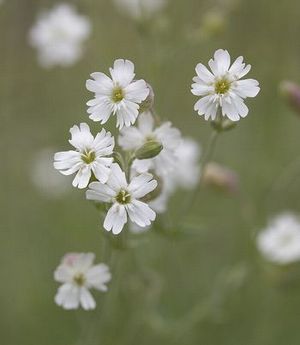Silene douglasii
Contents
Taxonomy
Description
General: Tufted perennial from a stout taproot and branched crown, the numerous, decumbent, simple stems 1-4 dm. tall, densely pubescent throughout. Leaves: Basal leaves matted, long-petiolate, oblanceolate to linear-lanceolate, 2-5 cm. long and 2-7 mm. wide; cauline leaves 1-8 pairs, becoming smaller and sessile above.
Flowers: Flowers few, with linear bracts, often remote; calyx tubular, 5-lobed, 12-15 mm. long, becoming papery and enlarged in fruit; petals 5, creamy-white, greenish, pink or purplish; claw 8-12 mm long, the blade oblong, 4-6 mm. long, bi-lobed about ¼ the length; blade appendages 2, oblong, 1 mm. long; ovary stalk 3-4 mm. long; stamens 10; styles 3.
Fruits: Capsule 1-celled.
Bloom Period
Late May - July [2]
Distribution
British Columbia to California, east to Montana and Utah; in both the Olympic and Cascades Mountains [3]
Habitat
Sagebrush plains to mountain slopes [4]
Uses
Infusion of roots taken as an emetic for stomach trouble pain; Warm infusion of pounded plant used as an emetic for stomach pain; Cold infusion used as lotion for coyote bite on man, sheep or horse; Plant used as a horse medicine.
Cite error: Invalid <ref> tag;
refs with no name must have content
Propagation
Easily propagated by cutting or seed [5]
Photo Gallery
References
- ↑ http://biology.burke.washington.edu/herbarium/imagecollection.php?Genus=Silene&Species=douglasii
- ↑ http://biology.burke.washington.edu/herbarium/imagecollection.php?Genus=Silene&Species=douglasii
- ↑ http://biology.burke.washington.edu/herbarium/imagecollection.php?Genus=Silene&Species=douglasii
- ↑ http://biology.burke.washington.edu/herbarium/imagecollection.php?Genus=Silene&Species=douglasii
- ↑ http://www.wildflower.org/plants/result.php?id_plant=SIDO

